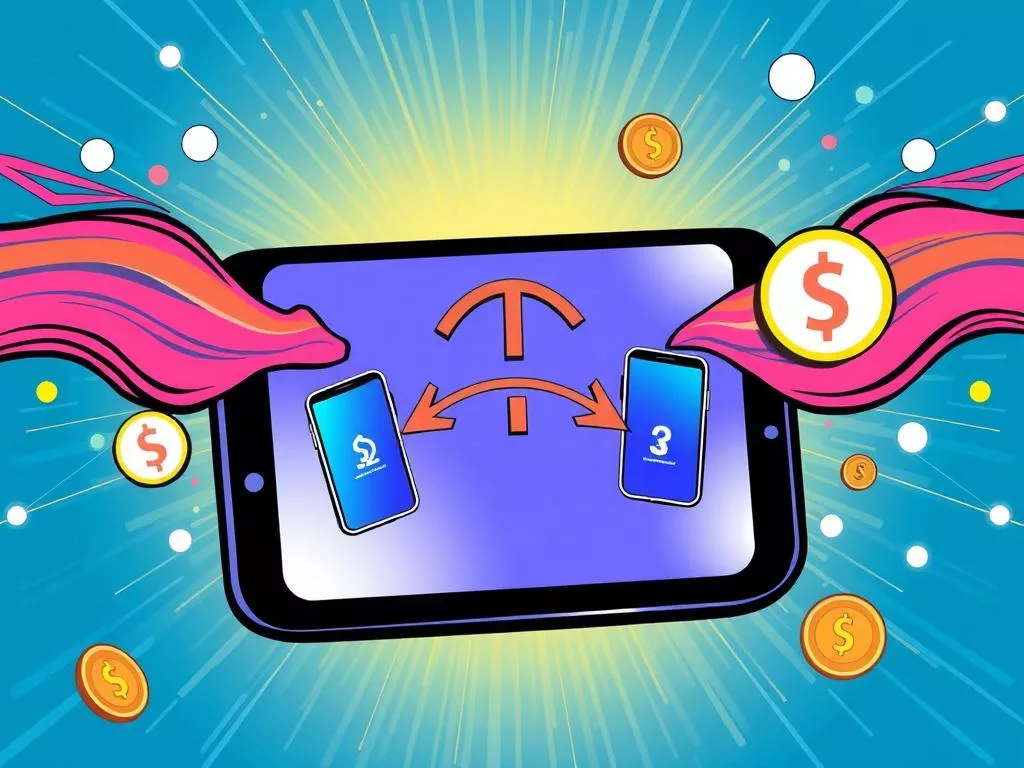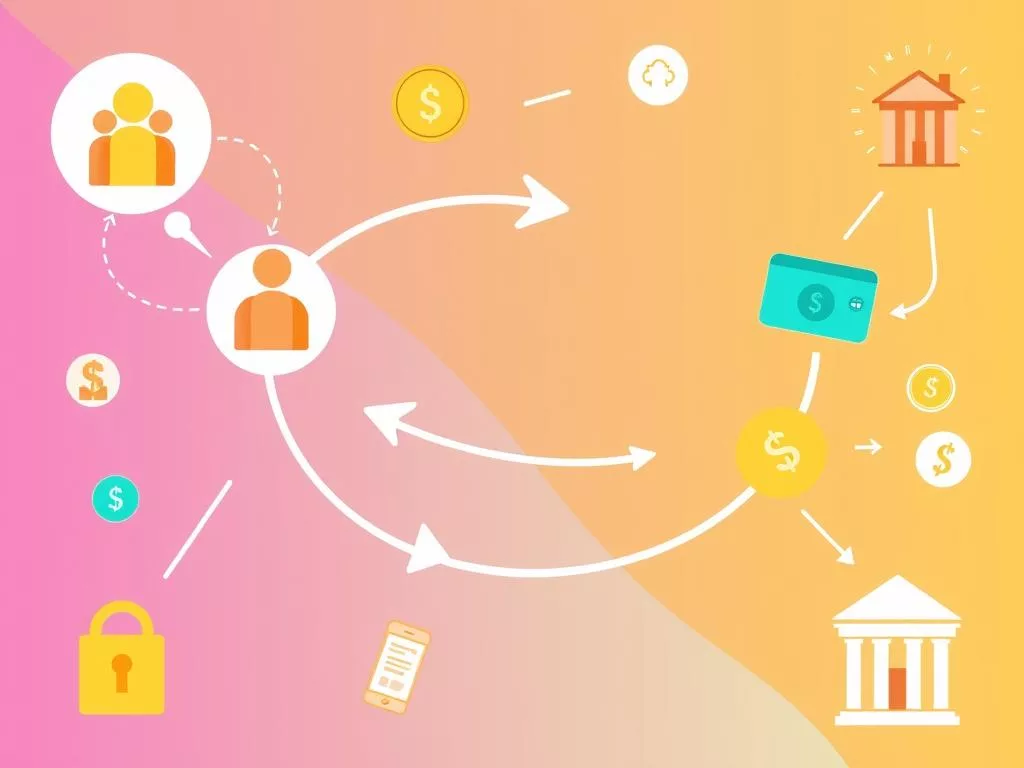Zelle is a new way to send money directly from one bank account to another. It was launched in 2017 by Early Warning Services, LLC. It’s fast and free, unlike some other services like PayPal and Venmo.
To use Zelle, I just need a mobile phone number or email address. This makes sending money easy and secure.
Many U.S. banks and credit unions, like Bank of America and Chase, support Zelle. But, the amount I can send varies by bank. Usually, it’s between $1,000 and $2,000 per day.
Zelle is quick, often processing payments in minutes. But, it’s important to be careful. Once I send money, I can’t get it back. So, I should only send to people or businesses I trust.
In this article, I’ll explore Zelle in more detail. We’ll look at how it works, setting up accounts, fees, and safety. For more information, check out this guide on Zelle.
Understanding the Basics of Zelle
Zelle is a new way to send and get money using your phone. It’s owned by Early Warning Services and is easy to use. You don’t have to share your bank details, which makes it safer.
With Zelle, you can send money to anyone, no matter their bank. Money usually gets there in minutes, which is faster than regular bank transfers. If you bank with places like Capital One, you can send up to $3,000 in 24 hours.
Knowing how Zelle works is key if you’re thinking about using it. Over 2,100 banks offer Zelle, reaching more than 150 million people. This shows how popular instant payments are becoming.
- Owned and operated by Early Warning Services
- No fees to send or receive money
- Transfers typically arrive within minutes
- Available through over 2,100 banks and credit unions
- Easy access for over 150 million users
How Does Zelle Work and What are the Transfer Limits?
Zelle lets users send and receive money easily using an email or phone number. This Zelle transfer process is quick, with funds arriving in minutes. It’s a great choice for many because it’s fast and simple.
To send money, just enter the recipient’s details and the amount. Then, start the payment. Usually, the money goes through almost right away.
Knowing about transfer limits is key for managing money well. These limits vary by bank. Banks set daily limits from $500 to $3,500.
For example, Bank of America lets you send up to $3,500 a day and $20,000 a month. Citibank offers $2,500 daily and $15,000 monthly for long-time customers.
The table below shows the Zelle transfer limits for different banks. It shows how limits can vary:
| Bank | Daily Limit | Monthly Limit |
|---|---|---|
| Bank of America | $3,500 | $20,000 |
| Citibank | $2,500 | $15,000 |
| TD Bank | $1,000 (Instant transfer) | $5,000 (Instant transfer) |
| Wells Fargo | $3,500 | $20,000 |
| Ally | $2,000 (Instant transfer) | $10,000 |
If your bank isn’t with Zelle, you can only send $500 at a time. You can receive up to $5,000 a week. It’s important to know these limits if you want to use Zelle well.

Zelle Account Setup Process
Setting up Zelle is easy and can be done in just a few minutes. First, I check if my bank supports Zelle. Over 1,700 institutions do, making the Zelle registration process simple.
Then, I download the Zelle app from the app store. After installing, the app asks me to link it to my bank account. I agree to terms, then verify my account via text or email. This makes setting up Zelle quick and easy.
After confirming, I can send money instantly. Money usually reaches the recipient in minutes if they’re set up with Zelle. If not, they get a notification to sign up. This way, managing my money is fast and efficient.
Transaction Fees and Limits of Zelle
Zelle is known for not charging any fees, which is a big plus. This makes it cheaper than many other payment services. Even though there are no fees, it’s important to know about the transfer limits.
Different banks have different daily limits for sending money with Zelle. Some banks let you send up to $500 a day. Others might have lower limits or more rules based on your account type. You can usually receive up to $5,000 a week, but this can change based on your bank’s rules.
Checking with your bank is a good idea to learn about specific limits. Some banks let you change Zelle transfer limits for bigger transactions. This can be useful for those who need to send more money.
Some banks offer special accounts with higher Zelle limits. These accounts might also have other perks like no fees and better security. If you have a verified account and a good transaction history, you might get these higher limits. It’s important to watch your account for any unusual activity to avoid overdraft fees.
If you often need to send more than the limits allow, you might want to look into other payment options. Venmo, PayPal, wire transfers, and electronic bill payments can handle bigger amounts. With over 90% of people using digital payments, Zelle is a solid choice. It processed over 2.3 billion transactions in 2022.
| Bank/Financial Institution | Daily Send Limit | Weekly Receive Limit | Notes |
|---|---|---|---|
| Bank of America | $1,000 | $5,000 | Limits apply based on account type. |
| Wells Fargo | $500 | $5,000 | Higher limits for premium accounts. |
| Chase | $2,000 | $16,000 | Higher limits for well-established accounts. |
| TD Bank | $1,000 | $5,000 | Standard limits; adjustments available. |

Participating Banks and Credit Unions
Zelle is a fast and easy way to send money. Over 1,700 financial institutions offer Zelle, reaching many users. Big banks like Bank of America, JP Morgan Chase, and Wells Fargo make it simple for their customers.
Citibank and TD Bank also use Zelle in their online and mobile banking. Credit unions, such as Navy Federal Credit Union, join in too. This wide network means fast transactions, often in just minutes.
Sunward Credit Union has limits for Zelle transactions. Members can send up to $1,000 at a time, with a daily limit of $1,000. Sunward doesn’t charge fees for Zelle, making it even more appealing.
To use Zelle, you need a U.S. bank account. Both the sender and recipient must have their accounts set up. If there’s an issue, like sending to the wrong person, contact the bank’s support. Sunward’s Contact Center is ready to help with Zelle questions and problems.
Zelle is changing how we make payments. With more banks and credit unions joining, it’s becoming a go-to for everyday transactions.
Is Zelle Safe to Use?
Understanding Zelle’s safety is key. It only works with federally insured banks, which protects users. To send money, you only need an email or phone number. This makes it hard for hackers to get your info.
But, even with strong security, be careful when sending to strangers. In 2022, the FTC said people lost $2.6 billion to scams. Zelle scams, like fake job offers, are common.
It’s best to only send money to people you know. Zelle doesn’t protect your money like credit cards do. If you send money by mistake, getting it back is hard.
Zelle has two-factor authentication to help keep your account safe. But, scams like debt collection are more common in places like Michigan and Tennessee. Always think twice before sending money to someone new.
By being careful and only sending to people you trust, you can use Zelle safely. It’s fast, but you must be cautious to avoid scams.

